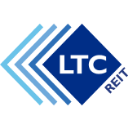LAND

Gladstone Land Corporation
LAND
(2.2)10,88 USD
1.31% ROA
2.05% ROE
27.55x PER
487.760.624,00 USD
85.98% DER
4.1% Yield
16.45% NPM
Gladstone Land Corporation Stock Analysis
Gladstone Land Corporation Fundamental Analysis
Fundamental analysis in stock investing is like studying the foundation of a house before buying it. It involves looking at a company's financial health, like its earnings, assets, and debts, to determine if it's a good investment based on its fundamental strength and potential for growth.
| # | Analysis | Rating |
|---|---|---|
| 1 |
PBV
With a remarkably low PBV ratio (0.7x), the stock offers substantial upside potential at a bargain price. |
|
| 2 |
Revenue Growth
Over the past five years, this company's revenue has consistently increased, demonstrating a robust financial performance that makes it an appealing opportunity. |
|
| 3 |
Dividend Growth
Investors can be encouraged by the company's strong dividend growth over the past five years, highlighting its ability to generate consistent returns and provide an attractive investment opportunity. |
|
| 4 |
Dividend
With a solid track record of dividend payments over the past five years, the company has established itself as a dependable choice for investors seeking consistent income. |
|
| 5 |
DER
The stock has a reasonable amount of debt compared to its ownership (81%), suggesting a balanced financial position and a moderate level of risk. |
|
| 6 |
ROE
Negative ROE (-0.24%) indicates poor financial performance, raising concerns about profitability and efficiency in utilizing shareholders' equity. |
|
| 7 |
ROA
The stock's ROA (-0.12%) indicates that it's not effectively utilizing its assets to generate profits, making it a less favorable option to invest and earn consistent returns. |
|
| 8 |
Net Profit Growth
This company's net profit has remained stagnant over the past five years, indicating a lack of growth and making it a less favorable investment option. |
|
| 9 |
Assets Growth
Company's revenue has stayed stagnant, showing no signs of improvement and making it a less favorable choice. |
|
| 10 |
Graham Number
The company's Graham number indicates that it is overvalued compared to its stock price, suggesting a potentially unfavorable investment opportunity. |
|
| 11 |
Buffet Intrinsic Value
The company's stock shows signs of being overvalued (-542) according to Warren Buffett's formula, indicating a potential downside as its market price exceeds its estimated intrinsic value. |
Gladstone Land Corporation Technical Analysis
Technical analysis in stock investing is like reading the patterns on a weather map to predict future weather conditions. It involves studying past stock price movements and trading volumes to make predictions about where a stock's price might go next, without necessarily looking at the company's financial health.
| # | Analysis | Recommendation |
|---|---|---|
| 1 | Awesome Oscillator | Buy |
| 2 | MACD | Buy |
| 3 | RSI | Hold |
| 4 | Stoch RSI | Sell |
Gladstone Land Corporation Price Chart
Financial Statements
Financial statements are like report cards for companies. They show how much money a company makes (income statement), what it owns and owes (balance sheet), and where it spends its money (cash flow statement), helping stock investors understand if a company is healthy and worth investing in.
Income Statements
An income statement for a company is like a scoreboard for its profits and losses. It shows how much money the company made (revenue) and how much it spent to make that money (expenses), helping stock investors see if a company is making a profit or not.
Revenue in stock investing is the total amount of money a company earns from its sales, and it's a key factor that investors consider to assess a company's financial performance and growth potential.
| Year | Revenue | Growth |
|---|---|---|
| 2010 | 2.418.111 | |
| 2011 | 2.964.082 | 18.42% |
| 2012 | 3.390.594 | 12.58% |
| 2013 | 4.038.138 | 16.04% |
| 2014 | 7.184.922 | 43.8% |
| 2015 | 11.901.461 | 39.63% |
| 2016 | 17.316.617 | 31.27% |
| 2017 | 25.122.000 | 31.07% |
| 2018 | 36.687.000 | 31.52% |
| 2019 | 40.692.000 | 9.84% |
| 2020 | 57.031.000 | 28.65% |
| 2021 | 75.318.000 | 24.28% |
| 2022 | 89.236.000 | 15.6% |
| 2023 | 94.136.000 | 5.21% |
| 2023 | 90.398.000 | -4.14% |
| 2024 | 85.188.000 | -6.12% |
Research and Development Expenses are the costs a company incurs to create and improve its products or services, which can be important for investors to evaluate a company's innovation and potential for future growth.
| Year | Research and Development Expenses | Growth |
|---|---|---|
| 2010 | 0 | |
| 2011 | 0 | 0% |
| 2012 | 0 | 0% |
| 2013 | 0 | 0% |
| 2014 | 0 | 0% |
| 2015 | 0 | 0% |
| 2016 | 0 | 0% |
| 2017 | 0 | 0% |
| 2018 | 0 | 0% |
| 2019 | 0 | 0% |
| 2020 | 0 | 0% |
| 2021 | 0 | 0% |
| 2022 | 0 | 0% |
| 2023 | 0 | 0% |
| 2023 | 0 | 0% |
| 2024 | 0 | 0% |
General and Administrative Expenses are the costs a company incurs to run its day-to-day operations, such as office rent, salaries, and utilities, which investors consider to understand a company's overall efficiency and management effectiveness.
| Year | General and Administrative Expenses | Growth |
|---|---|---|
| 2010 | 528.770 | |
| 2011 | 1.050.613 | 49.67% |
| 2012 | 771.634 | -36.15% |
| 2013 | 1.644.005 | 53.06% |
| 2014 | 2.894.440 | 43.2% |
| 2015 | 3.023.104 | 4.26% |
| 2016 | 3.806.891 | 20.59% |
| 2017 | 4.529.000 | 15.94% |
| 2018 | 5.477.000 | 17.31% |
| 2019 | 5.276.000 | -3.81% |
| 2020 | 7.839.000 | 32.7% |
| 2021 | 9.994.000 | 21.56% |
| 2022 | 13.052.000 | 23.43% |
| 2023 | 4.896.000 | -166.58% |
| 2023 | 6.950.000 | 29.55% |
| 2024 | 13.604.000 | 48.91% |
EBITDA stands for Earnings Before Interest, Taxes, Depreciation, and Amortization. It is a measure that helps stock investors analyze a company's profitability by looking at its earnings without considering certain expenses. This helps to get a clearer picture of the company's financial performance and its ability to generate cash flow.
| Year | EBITDA | Growth |
|---|---|---|
| 2010 | 1.181.229 | |
| 2011 | 982.888 | -20.18% |
| 2012 | 1.373.342 | 28.43% |
| 2013 | 2.079.908 | 33.97% |
| 2014 | 3.646.099 | 42.96% |
| 2015 | 7.842.000 | 53.51% |
| 2016 | 12.243.836 | 35.95% |
| 2017 | 18.613.000 | 34.22% |
| 2018 | -21.553.000 | 186.36% |
| 2019 | 31.201.000 | 169.08% |
| 2020 | 44.341.000 | 29.63% |
| 2021 | 58.171.000 | 23.77% |
| 2022 | 69.726.000 | 16.57% |
| 2023 | 36.976.000 | -88.57% |
| 2023 | 70.644.000 | 47.66% |
| 2024 | 66.708.000 | -5.9% |
Gross profit is the money a company makes from selling its products or services after subtracting the cost of producing or providing them, and it is an important measure for investors to understand a company's profitability.
| Year | Gross Profit | Growth |
|---|---|---|
| 2010 | 2.410.595 | |
| 2011 | 2.902.498 | 16.95% |
| 2012 | 3.301.223 | 12.08% |
| 2013 | 3.918.675 | 15.76% |
| 2014 | 6.750.408 | 41.95% |
| 2015 | 11.172.425 | 39.58% |
| 2016 | 16.646.666 | 32.88% |
| 2017 | 23.957.000 | 30.51% |
| 2018 | 34.644.000 | 30.85% |
| 2019 | 38.219.000 | 9.35% |
| 2020 | 55.183.000 | 30.74% |
| 2021 | 72.782.000 | 24.18% |
| 2022 | 86.417.000 | 15.78% |
| 2023 | 0 | 0% |
| 2023 | 77.594.000 | 100% |
| 2024 | 36.756.000 | -111.11% |
Net income in stock investing is like the money a company actually gets to keep as profit after paying all its bills, and it's an important measure to understand how well a company is doing financially.
| Year | Net Profit | Growth |
|---|---|---|
| 2010 | 560.523 | |
| 2011 | 6.219 | -8913.07% |
| 2012 | 600.373 | 98.96% |
| 2013 | -1.224.683 | 149.02% |
| 2014 | -125.133 | -878.71% |
| 2015 | 568.545 | 122.01% |
| 2016 | 448.102 | -26.88% |
| 2017 | -31.000 | 1545.49% |
| 2018 | 2.629.000 | 101.18% |
| 2019 | -13.695.000 | 119.2% |
| 2020 | -15.730.000 | 12.94% |
| 2021 | -20.550.000 | 23.45% |
| 2022 | -21.022.000 | 2.25% |
| 2023 | 12.564.000 | 267.32% |
| 2023 | 14.565.000 | 13.74% |
| 2024 | -3.292.000 | 542.44% |
EPS, or earnings per share, is a measure that shows how much profit a company has earned for each outstanding share of its stock, and it is important for stock investors as it helps understand the profitability of a company and compare it with other companies in the market.
| Year | Earning per Share (EPS) | Growth |
|---|---|---|
| 2010 | 0 | |
| 2011 | 0 | 0% |
| 2012 | 0 | 0% |
| 2013 | 0 | 0% |
| 2014 | 0 | 0% |
| 2015 | 0 | 0% |
| 2016 | 0 | 0% |
| 2017 | 0 | 0% |
| 2018 | 0 | 0% |
| 2019 | -1 | 0% |
| 2020 | -1 | 0% |
| 2021 | -1 | 0% |
| 2022 | -1 | 0% |
| 2023 | 0 | 0% |
| 2023 | 0 | 0% |
| 2024 | 0 | 0% |
Cashflow Statements
Cashflow statements show the movement of money in and out of a company, helping stock investors understand how much money a company makes and spends. By examining cashflow statements, investors can assess if a company is generating enough cash to pay its bills, invest in growth, and provide returns to stockholders.
Free cash flow is the leftover cash that a company generates after covering its operating expenses and capital expenditures, which is important for stock investors as it shows how much money a company has available to invest in growth, pay dividends, or reduce debt.
| Year | Free Cashflow | Growth |
|---|---|---|
| 2010 | 665.261 | |
| 2011 | 1.898.093 | 64.95% |
| 2012 | 1.137.777 | -66.82% |
| 2013 | -1.271.958 | 189.45% |
| 2014 | 924.538 | 237.58% |
| 2015 | 1.507.189 | 38.66% |
| 2016 | -1.394.916 | 208.05% |
| 2017 | 1.304.000 | 206.97% |
| 2018 | -12.197.000 | 110.69% |
| 2019 | 9.080.000 | 234.33% |
| 2020 | 8.492.000 | -6.92% |
| 2021 | 26.257.000 | 67.66% |
| 2022 | 23.662.000 | -10.97% |
| 2023 | 27.276.000 | 13.25% |
| 2023 | -4.207.000 | 748.35% |
| 2024 | 15.072.000 | 127.91% |
Operating cash flow represents the cash generated or consumed by a company's day-to-day operations, excluding external investing or financing activities, and is crucial for stock investors as it shows how much cash a company is generating from its core business operations.
| Year | Operating Cashflow | Growth |
|---|---|---|
| 2010 | 665.261 | |
| 2011 | 1.898.093 | 64.95% |
| 2012 | 1.137.777 | -66.82% |
| 2013 | -460.353 | 347.15% |
| 2014 | 3.543.622 | 112.99% |
| 2015 | 4.753.835 | 25.46% |
| 2016 | 8.402.522 | 43.42% |
| 2017 | 6.515.000 | -28.97% |
| 2018 | 10.408.000 | 37.4% |
| 2019 | 21.370.000 | 51.3% |
| 2020 | 25.002.000 | 14.53% |
| 2021 | 32.377.000 | 22.78% |
| 2022 | 43.788.000 | 26.06% |
| 2023 | 40.081.000 | -9.25% |
| 2023 | 80.000 | -50001.25% |
| 2024 | 15.913.000 | 99.5% |
Capex, short for capital expenditures, refers to the money a company spends on acquiring or upgrading tangible assets like buildings, equipment, or technology, which is important for stock investors as it indicates how much a company is investing in its infrastructure to support future growth and profitability.
| Year | Capital Expenditure | Growth |
|---|---|---|
| 2010 | 0 | |
| 2011 | 0 | 0% |
| 2012 | 0 | 0% |
| 2013 | 811.605 | 100% |
| 2014 | 2.619.084 | 69.01% |
| 2015 | 3.246.646 | 19.33% |
| 2016 | 9.797.438 | 66.86% |
| 2017 | 5.211.000 | -88.01% |
| 2018 | 22.605.000 | 76.95% |
| 2019 | 12.290.000 | -83.93% |
| 2020 | 16.510.000 | 25.56% |
| 2021 | 6.120.000 | -169.77% |
| 2022 | 20.126.000 | 69.59% |
| 2023 | 12.805.000 | -57.17% |
| 2023 | 4.287.000 | -198.69% |
| 2024 | 841.000 | -409.75% |
Balance Sheet
Balance sheets provide a snapshot of a company's financial health and its assets (such as cash, inventory, and property) and liabilities (like debts and obligations) at a specific point in time. For stock investors, balance sheets help assess the company's overall worth and evaluate its ability to meet financial obligations and support future growth.
Equity refers to the ownership interest or stake that shareholders have in a company, representing their claim on its assets and earnings after all debts and liabilities are paid.
| Year | Equity | Growth |
|---|---|---|
| 2010 | 8.547.633 | |
| 2011 | 7.536.353 | -13.42% |
| 2012 | 8.136.726 | 7.38% |
| 2013 | 48.511.992 | 83.23% |
| 2014 | 59.969.328 | 19.11% |
| 2015 | 78.006.719 | 23.12% |
| 2016 | 87.777.162 | 11.13% |
| 2017 | 117.951.000 | 25.58% |
| 2018 | 181.053.000 | 34.85% |
| 2019 | 278.970.000 | 35.1% |
| 2020 | 1.027.929.000 | 72.86% |
| 2021 | 589.066.000 | -74.5% |
| 2022 | 1.357.937.000 | 56.62% |
| 2023 | 1.336.560.000 | -1.6% |
| 2023 | 731.486.000 | -82.72% |
| 2024 | 708.469.000 | -3.25% |
Assets represent the valuable resources that a company owns, such as cash, inventory, property, and equipment, and understanding a company's assets helps investors assess its value and potential for generating future profits.
| Year | Assets | Growth |
|---|---|---|
| 2010 | 29.034.484 | |
| 2011 | 32.768.277 | 11.39% |
| 2012 | 40.500.901 | 19.09% |
| 2013 | 93.673.464 | 56.76% |
| 2014 | 151.702.624 | 38.25% |
| 2015 | 229.738.247 | 33.97% |
| 2016 | 333.985.019 | 31.21% |
| 2017 | 462.278.000 | 27.75% |
| 2018 | 565.119.000 | 18.2% |
| 2019 | 816.787.000 | 30.81% |
| 2020 | 1.067.289.000 | 23.47% |
| 2021 | 1.351.550.000 | 21.03% |
| 2022 | 1.457.251.000 | 7.25% |
| 2023 | 1.387.324.000 | -5.04% |
| 2023 | 1.406.112.000 | 1.34% |
| 2024 | 1.352.553.000 | -3.96% |
Liabilities refer to the financial obligations or debts that a company owes to creditors or external parties, and understanding a company's liabilities is important for investors as it helps assess the company's financial risk and ability to meet its obligations.
| Year | Liabilities | Growth |
|---|---|---|
| 2010 | 20.486.851 | |
| 2011 | 25.231.924 | 18.81% |
| 2012 | 32.364.175 | 22.04% |
| 2013 | 45.161.472 | 28.34% |
| 2014 | 91.733.296 | 50.77% |
| 2015 | 151.731.528 | 39.54% |
| 2016 | 246.207.857 | 38.37% |
| 2017 | 344.327.000 | 28.5% |
| 2018 | 384.066.000 | 10.35% |
| 2019 | 537.817.000 | 28.59% |
| 2020 | 683.499.000 | 21.31% |
| 2021 | 762.484.000 | 10.36% |
| 2022 | 725.889.000 | -5.04% |
| 2023 | 667.711.000 | -8.71% |
| 2023 | 674.626.000 | 1.03% |
| 2024 | 644.084.000 | -4.74% |
Gladstone Land Corporation Financial Ratio (TTM)
Valuation Metrics
- Revenue per Share
- 2.5
- Net Income per Share
- 0.49
- Price to Earning Ratio
- 27.55x
- Price To Sales Ratio
- 5.45x
- POCF Ratio
- 13.24
- PFCF Ratio
- 17.8
- Price to Book Ratio
- 0.69
- EV to Sales
- 11.71
- EV Over EBITDA
- 17.45
- EV to Operating CashFlow
- 28.47
- EV to FreeCashFlow
- 38.27
- Earnings Yield
- 0.04
- FreeCashFlow Yield
- 0.06
- Market Cap
- 0,49 Bil.
- Enterprise Value
- 1,05 Bil.
- Graham Number
- 14.82
- Graham NetNet
- -16.58
Income Statement Metrics
- Net Income per Share
- 0.49
- Income Quality
- 2.08
- ROE
- 0.02
- Return On Assets
- 0.01
- Return On Capital Employed
- 0
- Net Income per EBT
- 1
- EBT Per Ebit
- 6.75
- Ebit per Revenue
- 0.02
- Effective Tax Rate
- 0.36
Margins
- Sales, General, & Administrative to Revenue
- 0.13
- Research & Developement to Revenue
- 0
- Stock Based Compensation to Revenue
- 0
- Gross Profit Margin
- 0.46
- Operating Profit Margin
- 0.02
- Pretax Profit Margin
- 0.16
- Net Profit Margin
- 0.16
Dividends
- Dividend Yield
- 0.04
- Dividend Yield %
- 4.1
- Payout Ratio
- 2.58
- Dividend Per Share
- 0.56
Operating Metrics
- Operating Cashflow per Share
- 1.03
- Free CashFlow per Share
- 0.76
- Capex to Operating CashFlow
- 0.26
- Capex to Revenue
- 0.11
- Capex to Depreciation
- 0.26
- Return on Invested Capital
- 0
- Return on Tangible Assets
- 0.01
- Days Sales Outstanding
- 0
- Days Payables Outstanding
- 83.85
- Days of Inventory on Hand
- 0
- Receivables Turnover
- 0
- Payables Turnover
- 4.35
- Inventory Turnover
- 0
- Capex per Share
- 0.26
Balance Sheet
- Cash per Share
- 1,39
- Book Value per Share
- 19,77
- Tangible Book Value per Share
- 19.65
- Shareholders Equity per Share
- 19.77
- Interest Debt per Share
- 17.3
- Debt to Equity
- 0.86
- Debt to Assets
- 0.45
- Net Debt to EBITDA
- 9.34
- Current Ratio
- 3.42
- Tangible Asset Value
- 0,70 Bil.
- Net Current Asset Value
- -0,59 Bil.
- Invested Capital
- 76365000
- Working Capital
- 0,04 Bil.
- Intangibles to Total Assets
- 0
- Average Receivables
- 0,00 Bil.
- Average Payables
- 0,01 Bil.
- Average Inventory
- 0
- Debt to Market Cap
- 1.25
Dividends
Dividends in stock investing are like rewards that companies give to their shareholders. They are a portion of the company's profits distributed to investors, typically in the form of cash payments, as a way for them to share in the company's success.
| Year | Dividends | Growth |
|---|---|---|
| 2013 | 1 | |
| 2014 | 0 | 0% |
| 2015 | 0 | 0% |
| 2016 | 0 | 0% |
| 2017 | 1 | 0% |
| 2018 | 1 | 0% |
| 2019 | 1 | 0% |
| 2020 | 1 | 0% |
| 2021 | 1 | 0% |
| 2022 | 1 | 0% |
| 2023 | 1 | 0% |
| 2024 | 0 | 0% |
Gladstone Land Corporation Profile
About Gladstone Land Corporation
Founded in 1997, Gladstone Land is a publicly traded real estate investment trust that acquires and owns farmland and farm-related properties located in major agricultural markets in the U.S. and leases its properties to unrelated third-party farmers. The Company, which reports the aggregate fair value of its farmland holdings on a quarterly basis, currently owns 127 farms, comprised of approximately 94,000 acres in 13 different states, valued at approximately $1.0 billion. Gladstone Land's farms are predominantly located in regions where its tenants are able to grow fresh produce annual row crops, such as berries and vegetables, which are generally planted and harvested annually. The Company also owns farms growing permanent crops, such as almonds, apples, figs, olives, pistachios, and other orchards, as well as blueberry groves and vineyards, which are generally planted every 10 to 20-plus years and harvested annually. The Company may also acquire property related to farming, such as cooling facilities, processing buildings, packaging facilities, and distribution centers. The Company pays monthly distributions to its stockholders and has paid 93 consecutive monthly cash distributions on its common stock since its initial public offering in January 2013. The Company has increased its common distributions 20 times over the prior 23 quarters, and the current per-share distribution on its common stock is $0.0449 per month, or $0.5388 per year.
- CEO
- Mr. David John Gladstone
- Employee
- 70
- Address
-
1521 Westbranch Drive
McLean, 22102
Gladstone Land Corporation Executives & BODs
| # | Name | Age |
|---|---|---|
| 1 |
Mr. John Anthony Dellafiora Jr., CPA Chief Compliance Officer |
70 |
| 2 |
Mr. William Reiman Executive Vice President of West Coast Operations |
70 |
| 3 |
Ms. Jennifer A. Smith Chief Valuation Officer |
70 |
| 4 |
Mr. Lewis Parrish CPA Chief Financial Officer & Assistant Treasurer |
70 |
| 5 |
Ms. Karin McLaughlin Investor Relations Specialist |
70 |
| 6 |
Mr. Michael Bernard LiCalsi Esq., J.D. General Counsel & Secretary |
70 |
| 7 |
Ms. Paula Novara Head of Resource Management & Director |
70 |
| 8 |
Mr. David John Gladstone Founder, Chairman, Chief Executive Officer & President |
70 |




